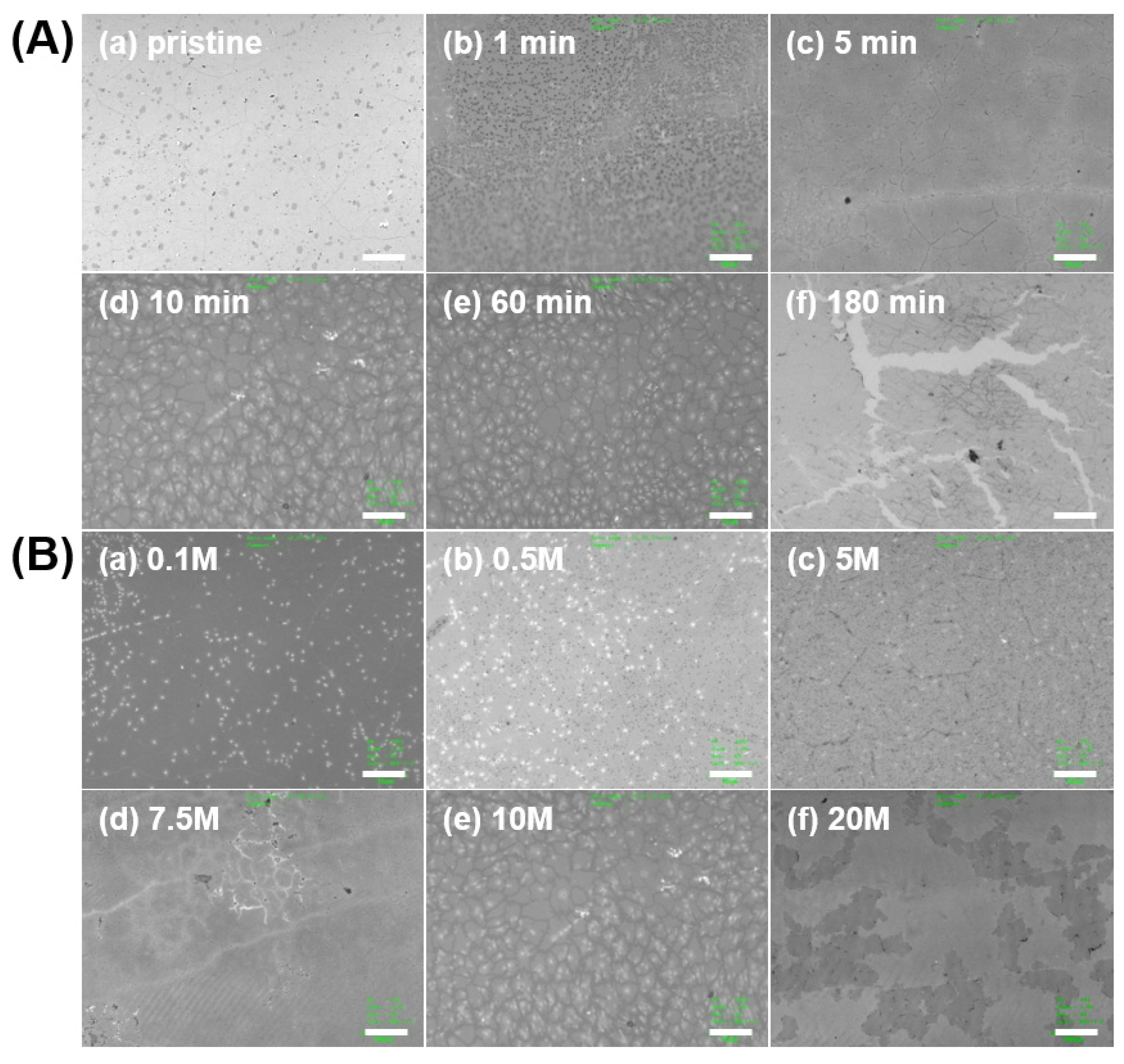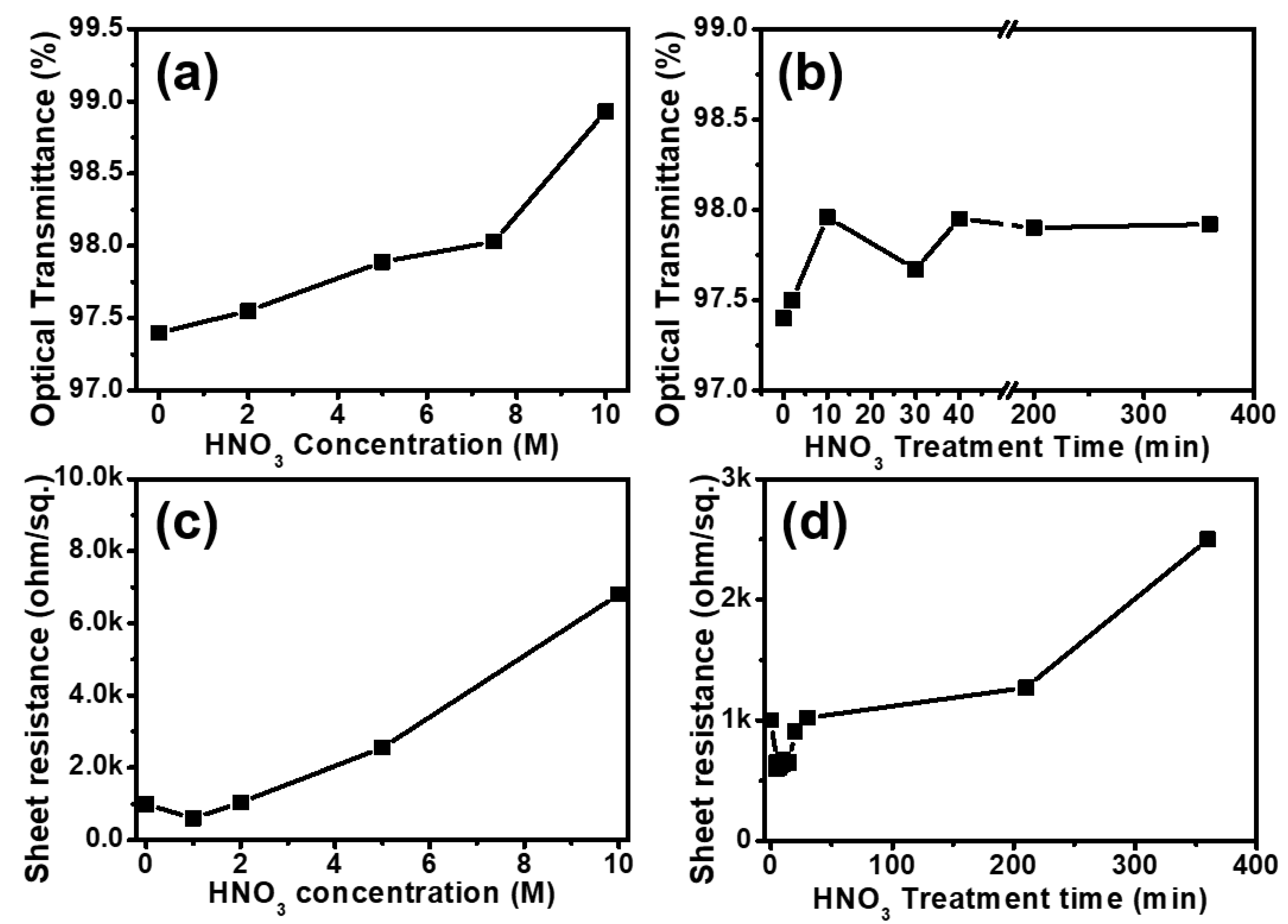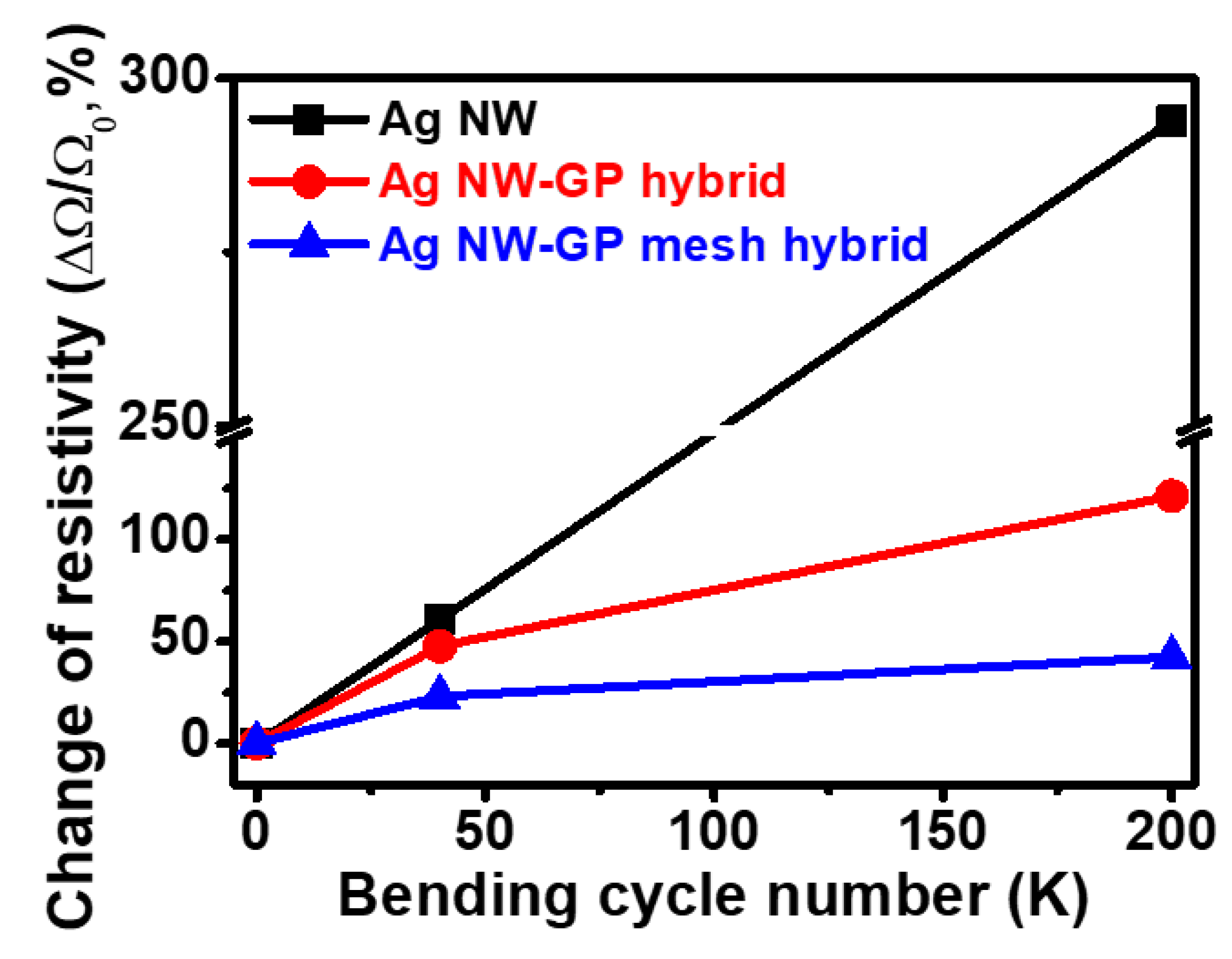Novel Hybrid Conductor of Irregularly Patterned Graphene Mesh and Silver Nanowire Networks
Abstract
:1. Introduction
2. Materials and Methods
2.1. Material Syntheses
2.2. Material Characterizations
2.3. Mechano-Electric Characterization
3. Results and Discussion
3.1. The Hybrid Conductor of Ag NW and Irregularly Patterned GP Mesh
3.2. Electro-Optical and Mechano-Electric Characteristics of Conducting Films
4. Conclusions
- Facile and simplified fabrication process: The hybrid conductor of Ag NW-irregularly patterned GP meshes on various flexible plastic substrates can be prepared via simple and facile chemical etching and solution deposition process without using complicated vacuum technology process.
- Tunable pattern shape and size: The shape and size of patterned GP mesh can be judiciously regulated by controlling the concentration and treatment time of etchant chemicals.
- Controllable electrical-optical properties: The optical transmittance and electrical conductivity of the GP mesh can be regulated by the concentration and treatment time of chemical etchant (HNO3). Judicious control of etching condition allows the enhanced optical transmittance and controlled conductivity of the hybrid conductor.
- Prevented Moiré effect: In contrast to conventional GP mesh containing regular array patterns, GP mesh with irregular patterns can prevent the Moiré phenomena, allowing high resolution display image in the flexible TCE.
- Enhanced mechano-electric stability: A hybrid conductor of Ag NW and GP mesh exhibits enhanced mechano-electric stability (ΔR/Ro: 42.4% at 200k cycles) at elongated bending/unbending cycles under 1R curvature (6.7% strain), superior to that of controls (Ag NW and Ag NW-pristine GP hybrid). Such an improved bending stability of our hybrid conductor can be ascribed to (i) combined electronic pathway formation among Ag NWs and GP mesh, (ii) elastic nature of Ag NW, and (iii) enhanced adhesion with Ag NW with substrate caused by GP mesh.
Supplementary Materials
Author Contributions
Funding
Conflicts of Interest
References
- Hecht, D.S.; Hu, L.; Irvin, G. Emerging Transparent Electrodes Based on Thin Films of Carbon Nanotubes, Graphene, and Metallic Nanostructures. Adv. Mater. 2011, 23, 1482–1513. [Google Scholar]
- Kumar, A.; Zhou, C. The Race to Replace Tin-Doped Indium Oxide: Which Material Will Win? ACS Nano 2010, 4, 11–14. [Google Scholar]
- Sohn, H.; Kim, S.Y.; Shin, W.; Lee, J.M.; Moon, K.-S.; Lee, H.; Yun, D.-J.; Han, I.T.; Kwak, C.; Hwang, S.-J. Novel Flexible Transparent Conductive Films with Enhanced Chemical and Electro-Mechanical Sustainability: TiO2 Nanosheet-Ag Nanowire Hybrid. ACS Appl. Mater. Interfaces 2018, 10, 2688–2700. [Google Scholar]
- Sohn, H.; Park, C.; Oh, J.-M.; Kang, S.W.; Kim, M.-J. Silver Nanowire Networks: Mechano-Electric Properties and Applications. Materials 2019, 12, 2526. [Google Scholar] [CrossRef] [Green Version]
- Hwang, C.; An, J.; Choi, B.D.; Kim, K.; Jung, S.-W.; Baeg, K.-J.; Kim, M.-G.; Ok, K.M.; Hong, J. Controlled Aqueous Synthesis of Ultra-Long Copper Nanowires for Stretchable Transparent Conducting Electrode. J. Mater. Chem. C 2016, 4, 1441–1447. [Google Scholar]
- Yu, L.P.; Shearer, C.; Shapter, J. Recent Development of Carbon Nanotube Transparent Conductive Films. Chem. Rev. 2016, 116, 13413–13453. [Google Scholar]
- Liu, B.; Li, C.; Liu, Q.-L.; Dong, J.; Guo, C.-W.; Wu, H.; Zhou, H.-Y.; Fan, X.-J.; Guo, X.; Wang, C.; et al. Hybrid film of Silver Nanowires and Carbon Nanotubes as a Transparent Conductive Layer in Light-Emitting Diodes. Appl. Phys. Lett. 2015, 106, 033101. [Google Scholar] [CrossRef]
- Liang, J.; Li, L.; Tong, K.; Ren, Z.; Hu, W.; Niu, X.; Chen, Y.; Pei, Q. Silver Nanowire Percolation Network Soldered with Graphene Oxide at Room Temperature and Its Application for Fully Stretchable Polymer Light-Emitting Diodes. ACS Nano 2014, 8, 1590–1600. [Google Scholar]
- Sohn, H.; Woo, Y.S.; Shin, W.; Yun, D.-J.; Lee, T.; Kim, F.S.; Hwang, J. Novel Transparent Conductor with Enhanced Conductivity: Hybrid of Silver Nanowires and Dual-Doped Graphene. Appl. Surf. Sci. 2017, 419, 63–69. [Google Scholar]
- Lee, H.; Kim, I.; Kim, M.; Lee, H. Moving Beyond Flexible to Stretchable Conductive Electrodes using Metal Nanowires and Graphenes. Nanoscale 2016, 8, 1789–1822. [Google Scholar]
- Cho, E.H.; Kim, M.-J.; Sohn, H.; Shin, W.H.; Won, J.Y.; Kim, Y.; Kwak, C.; Lee, C.S.; Woo, Y.S. A Graphene Mesh as a Hybrid Electrode for Foldable Devices. Nanoscale 2018, 10, 628–638. [Google Scholar] [CrossRef]
- Guenes, F.; Han, G.H.; Kim, K.K.; Kim, E.S.; Chae, S.J.; Park, M.H.; Jeong, H.-K.; Lim, S.C.; Lee, Y.H. Large-Area Graphene-based Flexible Transparent Conducting Films. Nano 2009, 4, 83–90. [Google Scholar] [CrossRef] [Green Version]
- Feng, J.; Li, W.; Qian, X.; Qi, J.; Qi, L.; Li, J. Patterning of graphene. Nanoscale 2012, 4, 4883–4899. [Google Scholar] [CrossRef]
- Shukla, S.; Kang, S.-Y.; Saxena, S. Synthesis and patterning of Graphene: Strategies and Prospects. Appl. Phys. Rev. 2019, 6, 021311. [Google Scholar] [CrossRef]
- Cagliani, A.; Lindvall, N.; Larsen, M.B.B.S.; Mackenzie, D.M.A.; Jensen, B.; Booth, T.J.; Bøggild, P. Defect/Oxygen Assisted Direct Write Technique for Nanopatterning Graphene. Nanoscale 2015, 7, 6271–6277. [Google Scholar] [CrossRef] [Green Version]
- Melinte, G.; Moldovan, S.; Hirlimann, C.; Baaziz, W.; Bégin-Colin, S.; Pham-Huu, C.; Ersen, O. Catalytic Nanopatterning of Few-Layer Graphene. ACS Catal. 2017, 7, 5941–5949. [Google Scholar] [CrossRef]
- Bell, D.C.; Lemme, M.C.; Stern, L.A.; Williams, J.R.; Marcus, C.M. Precision Cutting and Patterning of Graphene with Helium Ions. Nanotechnology 2009, 20, 455301. [Google Scholar] [CrossRef]
- Ding, J.; Du, K.; Wathuthanthri, I.; Choi, C.-H.; Fisher, F.T.; Yang, E.-H. Transfer Patterning of Large-Area Graphene Nanomesh via Holographic Lithography and Plasma Etching. J. Vac. Sci. Technol. B 2014, 32, FF01. [Google Scholar] [CrossRef]
- Mashiyama, D.; Tobe, T.; Ogino, T. Nanopatterning of Suspended Graphene Films by Local Catalytic Etching Using Atomic Force Microscopy Equipped with an Ag-coated Probe. J. Phys. Chem. C 2015, 119, 11914–11921. [Google Scholar] [CrossRef]
- Hong, B.H.; Han, J.H. Patterning Method of Graphene using Hot Embossing Imprinting. Korean Patent KR10-1571317, 8 May 2018. [Google Scholar]
- Vicarelli, L.; Heerema, S.J.; Dekker, C.; Zandbergen, H.W. Controlling Defects in Graphene for Optimizing the Electrical Properties of Graphene Nanodevices. ACS Nano 2015, 9, 3428–3435. [Google Scholar] [CrossRef]
- Sommer, B.; Sonntag, J.; Ganczarczyk, A.; Braam, D.; Prinz, G.; Lorke, A.; Geller, M. Electron-Beam Induced Nano-Etching of Suspended Graphene. Sci. Rep. 2015, 5, 7781–7785. [Google Scholar] [CrossRef] [Green Version]
- Kumar, P.; Subrahmanyam, K.S.; Rao, C.N.R. Graphene Patterning and Lithography Employing Laser/Electron-Beam Reduced Graphene Oxide and Hydrogenated Graphene. Mater. Exp. 2011, 1, 252–256. [Google Scholar] [CrossRef]
- Climent-Pascual, E.; Garcia-Velez, M.; Alvarez, A.L.; Coya, C.; Munuera, C.; Diez-Betriu, X.; Garcia-Hernandez, M.; de Andres, A. Large Area Graphene and Graphene Oxide Patterning and Nanographene Fabrication by One-step Lithography. Carbon 2015, 90, 110–121. [Google Scholar] [CrossRef]
- Zhu, S.; Huang, Y.; Li, T. Extremely Compliant and Highly Stretchable Patterned Graphene. Appl. Phys. Lett. 2014, 104, 173103. [Google Scholar] [CrossRef] [Green Version]
- Pérez-Mas, A.M.; Álvarez, P.; Campos, N.; Gómez, D.; Menéndez, R. Graphene patterning by Nanosecond Laser Ablation: The Effect of the Substrate Interaction with Graphene. J. Phys. D Appl. Phys. 2016, 49, 305301. [Google Scholar] [CrossRef] [Green Version]
- Erps, J.V.; Ciuk, T.; Pasternak, I.; Krajewska, A.; Strupinski, W.; Put, S.V.; Steenberge, G.V.; Baert, K.; Terryn, H.; Thienpont, H.; et al. Laser Ablation- and Plasma Etching-based Patterning of Graphene on Silicon-On-Insulator Waveguides. Opt. Exp. 2015, 23, 026639–026650. [Google Scholar] [CrossRef] [Green Version]
- Xu, Q.; Wu, M.-Y.; Schneider, G.F.; Houben, L.; Malladi, S.K.; Dekker, C.; Yucelen, E.; Dunin-Borkowski, R.E.; Zandbergen, H.W. Controllable Atomic Scale Patterning of Freestanding Monolayer Graphene at Elevated Temperature. ACS Nano 2013, 7, 1566–1572. [Google Scholar] [CrossRef]
- Kim, K.S.; Zhao, Y.; Jang, H.; Lee, S.Y.; Kim, J.M.; Kim, K.S.; Ahn, J.-H.; Kim, P.; Choi, J.-Y.; Hong, B.H. Large-Scale Pattern Growth of Graphene Films for Stretchable Transparent Electrodes. Nature 2009, 457, 706–710. [Google Scholar] [CrossRef]
- Jin, Z.; Sun, W.; Ke, Y.; Shih, C.-J.; Paulus, G.L.C.; Wang, Q.H.; Mu, B.; Yin, P.; Strano, M.S. Metallized DNA Nanolithography for Encoding and Transferring Spatial Information for Graphene Patterning. Nat. Commun. 2013, 4, 1663–1671. [Google Scholar] [CrossRef]
- Dimiev, A.; Kosynkin, D.V.; Sinitskii, A.; Slesarev, A.; Sun, Z.; Tour, J.M. Layer-by-Layer Removal of Graphene for Device Patterning. Science 2011, 331, 1168–1172. [Google Scholar] [CrossRef]
- Zhang, L.; Diao, S.; Nie, Y.; Yan, K.; Liu, N.; Dai, B.; Xie, Q.; Reina, A.; Kong, J.; Liu, Z. Photocatalytic Patterning and Modification of Graphene. J. Am. Chem. Soc. 2011, 133, 2706–2713. [Google Scholar] [CrossRef]
- Choi, D.; Kuru, C.; Choi, C.; Noh, K.; Hong, S.-K.; Das, S.; Choi, W.; Jin, S. Nanopatterned Graphene Field Effect Transistor Fabricated Using Block Co-polymer Lithography. Mater. Res. Lett. 2014, 2, 131–139. [Google Scholar] [CrossRef]
- Jin, C.; Olsen, B.C.; Luber, E.J.; Buriak, J.M. Preferential Alignment of Incommensurate Block Copolymer Dot Arrays Forming Moireé Superstructures. ACS Nano 2017, 11, 3237–3246. [Google Scholar] [CrossRef] [Green Version]
- Yoon, J.-W.; Park, Y.-G.; Park, C.-J.; Kim, D.-I.; Lee, J.-H.; Chung, N.-K.; Choe, B.-Y.; Suh, T.-S.; Lee, H.-K. Reduction of a Grid Moiré Pattern by Integrating a Carbon-Interspaced High Precision x-ray Grid with a Digital Radiographic Detector. Med. Phys. 2007, 34, 4092–4097. [Google Scholar] [CrossRef]
- Trung, T.N.; Kim, D.-O.; Kim, E.-T. Direct and Self-Selective Synthesis of Ag Nanowires on Patterned Graphene. RSC Adv. 2017, 7, 17325–17331. [Google Scholar] [CrossRef] [Green Version]
- Li, X.; Xie, D.; Park, H.; Zhu, M.; Zeng, T.H.; Wang, K.; Wei, J.; Wu, D.; Kong, J.; Zhu, H. Ion Doping of Graphene for High-Efficiency Heterojunction Solar Cells. Nanoscale 2013, 5, 1945–1948. [Google Scholar] [CrossRef]
- Das, S.; Sudhagar, P.; Ito, E.; Lee, D.-Y.; Nagarajan, S.; Lee, S.Y.; Kang, Y.S.; Choi, W. Effect of HNO3 Functionalization on Large Scale Graphene for Enhanced Tri-iodide Reduction in Dye-Sensitized Solar Cells. J. Mater. Chem. 2012, 22, 20490–20497. [Google Scholar] [CrossRef]
- Bae, S.; Kim, H.; Lee, Y.; Xu, X.; Park, J.-S.; Zheng, Y.; Balakrishnan, J.; Lei, T.; Kim, H.R.; Song, Y.I.; et al. Roll-to-roll Production of 30-inch Graphene Films for Transparent Electrodes. Nat. Nanotech. 2010, 5, 574–578. [Google Scholar] [CrossRef] [Green Version]
- Li, T.-T.; Zhong, Y.; Yan, M.; Zhou, W.; Xu, W.; Huang, S.-Y.; Sun, F.; Lou, C.-W.; Lin, J.-H. Synergistic Effect and Characterization of Graphene/Carbon Nanotubes/Polyvinyl Alcohol/Sodium Alginate Nanofibrous Membranes Formed Using Continuous Needleless Dynamic Linear Electrospinning. Nanomaterials 2019, 9, 714. [Google Scholar] [CrossRef] [Green Version]
- Lee, M.-S.; Kim, J.; Park, J.; Park, J.-U. Studies on the Mechanical Stretchability of Transparent Conductive Film based on Graphene-Metal Nanowire Structures. Nano Res. Lett. 2015, 10, 27–35. [Google Scholar] [CrossRef] [Green Version]







© 2020 by the authors. Licensee MDPI, Basel, Switzerland. This article is an open access article distributed under the terms and conditions of the Creative Commons Attribution (CC BY) license (http://creativecommons.org/licenses/by/4.0/).
Share and Cite
Sohn, H.; Shin, W.H.; Seok, D.; Lee, T.; Park, C.; Oh, J.-M.; Kim, S.Y.; Seubsai, A. Novel Hybrid Conductor of Irregularly Patterned Graphene Mesh and Silver Nanowire Networks. Micromachines 2020, 11, 578. https://doi.org/10.3390/mi11060578
Sohn H, Shin WH, Seok D, Lee T, Park C, Oh J-M, Kim SY, Seubsai A. Novel Hybrid Conductor of Irregularly Patterned Graphene Mesh and Silver Nanowire Networks. Micromachines. 2020; 11(6):578. https://doi.org/10.3390/mi11060578
Chicago/Turabian StyleSohn, Hiesang, Weon Ho Shin, Dohyeong Seok, Taek Lee, Chulhwan Park, Jong-Min Oh, Se Yun Kim, and Anusorn Seubsai. 2020. "Novel Hybrid Conductor of Irregularly Patterned Graphene Mesh and Silver Nanowire Networks" Micromachines 11, no. 6: 578. https://doi.org/10.3390/mi11060578





